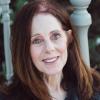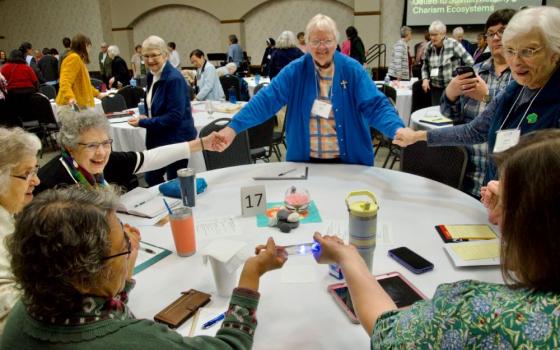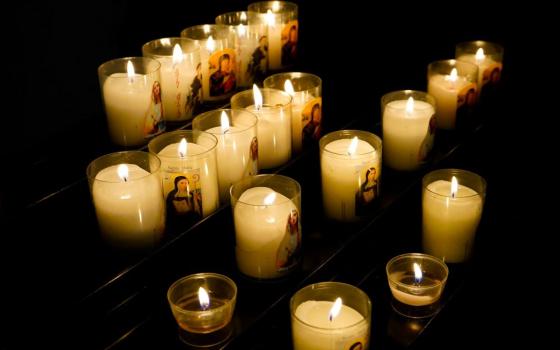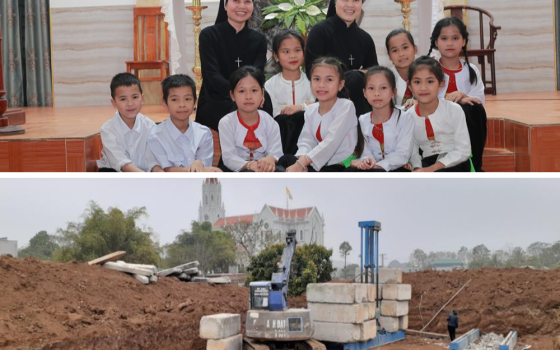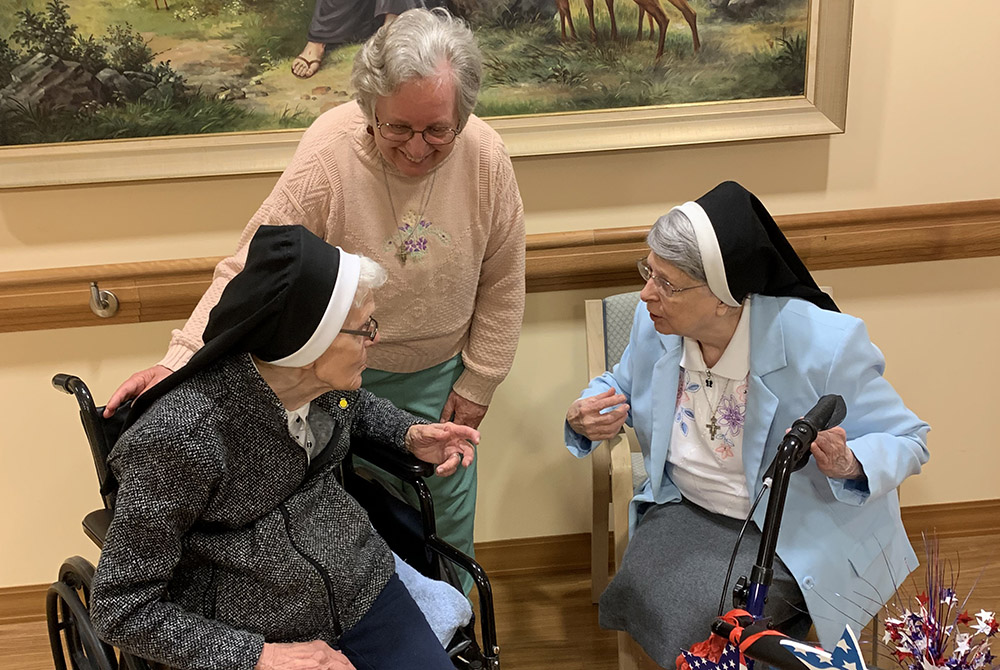
Sr. Benilda Nadolski, 99, left, the eldest of the Franciscan Sisters of St. Joseph and in the 79th year of her religious profession, converses with Sr. Marcia Ann Fiutko, center, and Sr. Alexine Machowicz, 89, at St. Francis Park this past spring. (Courtesy of Marcia Ann Fiutko)
When it comes to aging gracefully, nuns could teach the rest of us a thing or two. That's essentially what gerontologist David Snowdon argued 20 years ago in the wake of a study that is still generating interest among neurologists and other scientists looking for clues to stemming diseases like Alzheimer's.
The irony is that the so-called "Nun Study" relies on the donated brains of sisters who had agreed that he and other scientists could study them to learn more about the causes and effects of Alzheimer's disease on that organ.
Based on 25 years of research on a population of 678 American School Sisters of Notre Dame (Snowdon notes a remarkable 66% of eligible nuns participated), it was written in accessible prose suitable for readers eager to glean the secrets of healthy aging. The volume was titled: Aging with Grace: What the Nun Study Teaches Us About Leading Longer, Healthier, and More Meaningful Lives (Bantam Books, 2001).
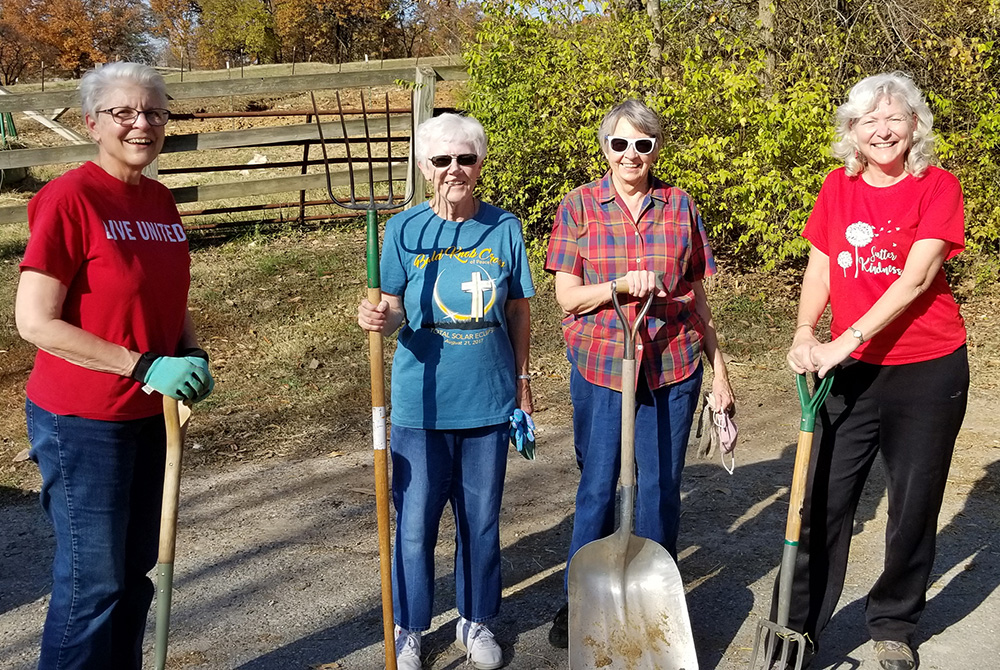
Sr. Anna Marie Reha, 60, far right, a provincial councilor for the School Sisters of Notre Dame, helps, from left, Barbara Neist, 74, Nancy Flamm, 77, and Rose Rita Huelsmann, 77, in October 2020, preparing the gardens in St. Louis for winter. (Courtesy of Anna Marie Reha)
A procession of nuns, each with her own particular history and personality, enliven the volume's more technical details. Take Sister Mary, for example. Born in 1892, Sister Mary taught seventh and eighth grades for 42 years, finally retiring from part-time work at 84. "But if you asked her, Sister Mary would not admit to being retired. 'I only retire at night,' she would say," wrote Snowdon.
In a formal Nun Study assessment soon after she turned 101, he recounted, Sister Mary performed "remarkably well." Her autopsied brain, though it did have tangles often associated with Alzheimer's, helped bolster the evidence that the risk of the disease doesn't necessarily rise among the oldest of the old, he noted.
Dr. Charlene Zeisset, a School Sister of Notre Dame and the physician who is the liaison to the project, responded matter-of-factly when asked if the sisters who donated their brains had seen anything extraordinary about their gift, saying that they were pretty humble about the project. "We are educators, in whatever we do. It was a way that the sisters could continue their ministry of education."

Sr. Charlene Zeisset, a School Sister of Notre Dame and a physician, is the current liaison to the ongoing work of the so-called "Nun Study." Here she is pictured standing in a room filled with the donated brains of other SSND sisters. Zeisset said she knew many of the study subjects from her province. (Courtesy of Charlene Zeisset)
But as she recalled entering a large room filled with the brains of her deceased community members in 2015, she said that she had known the women in her own province personally. "It was a holy place."
In early June, the Nun Study (which relies on the brains of the original sisters) moved to Northwestern University, where it will continue under the supervision of primary investigator Dr. Margaret Flanagan.
The topic itself is fraught by the fact that the ranks of sisters are thinning over time. In 2020, there were approximately only 41,000 women religious in the United States.
Advertisement
Many congregations, both female and male, lost members to COVID-19. GSR found that some sisters experienced the pain of isolation and grief over losing friends, not seeing family or missing significant anniversaries.
But Sr. Anna Marie Reha, a School Sister of Notre Dame and a provincial councilor for the St. Louis, Missouri-based Central Pacific Province, said that though sisters had died from COVID-19, she marveled at how full of life their aging compatriots remained. Last September one 90-year-old member called her and said, "I give up."

LCWR executive director Sr. Carol Zinn waits for an audience with Pope Francis during the International Union of Superiors General plenary in May in Rome. (Courtesy of LCWR)
"What do you mean, you give up?" Reha asked her, concerned. "Everything is online, and I need an iPad," responded the sister.
As Presentation of the Blessed Virgin Mary Sr. Stephanie Still, who heads the National Religious Retirement Office for the U.S. Conference of Catholic Bishops, points out, 40% of women's religious communities have 25 or fewer members. Some women religious are surrendering their motherhouses, moving into public facilities, merging with other congregations, or making other changes.
Carol Zinn, the executive director of the Leadership Conference of Women Religious, pushes back against the idea that there is something unique about the way that women religious grow old. Women in religious communities don't have a corner on the market, said the Sister of St. Joseph, "on how to go through this life journey, age gracefully or better than anybody else. It's really not about that. It's much more about having your whole life available to God's invitation to be faithful, be of service."
Whether it's nuns or your Florida-bound neighbor, "there's something very natural and holy about an aging process and the elders have wisdom that shouldn't get lost," she said.
Healthy aging, said Zinn, is "whatever is holy and healthy for human beings: to be in relationships, have a meaningful prayer life and a way of being of service to other people. These are a given in religious life, but I really think that they are a given in a happy, holy human life."
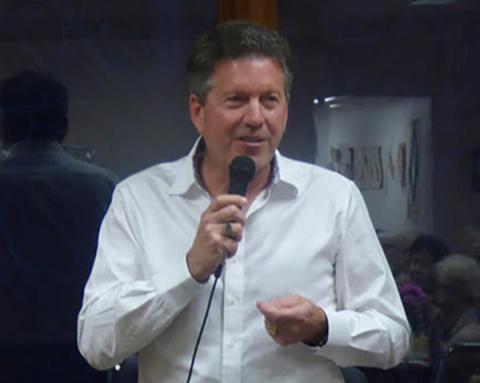
Clinical psychologist Ted Dunn consults with Catholic religious communities and other faith-based groups experiencing changes and contemplating the future. This photo was taken a few years ago when he was working with Our Lady of Victory Missionary Sisters in Huntington, Indiana. (Photo courtesy of Ted Dunn).
Letting go in community
Clinical psychologist Ted Dunn, who consults nationally and internationally with religious communities, doesn't minimize the challenges or the pain that can accompany the losses that come with age. "No matter how strong your faith life is, or your psychological resiliency, you've got to go through a process of letting go."
At the same time, he said, "what an enormous gift that is, being with your peers, facing these challenges in a communal setting. There is a lot of benefit to being in a community going through this experience with all the support and understanding a community can provide."
Unlike most other Americans, he said, sisters are already accustomed to congregate living. Even sisters with dementia are cared for by others. "They are brought along and are part of the family together. They can teach senior care facilities a lot about what it means to be living with a bunch of people and how to do that in a way that is nourishing."
Two very different communities offer some evidence that there is much laypeople and organizations could learn from the way that they treat their sisters.
Reha, a member of the same order that donated their brains to the Nun Study, is at 60 one of the youngest members of her province in an international order that still has thousands of members. While some sisters still fall prey to dementia, she said, "we really work to keep them active and engaged to the degree that they are able."
In her province, sisters in their 80s and 90s still serve on committees like the one for justice and peace participating in online conference calls. When they need assistance or memory care, they still live with members of their own communities, with a community leader assigned to help them with tasks like making doctor's appointments and coordinating transportation.
Embedded in their constitution, said Reha, is the belief that sickness and suffering, which outsiders might view as diminishment, actually offers a chance for members to experience personal growth and deeper ties with others. "Our elderly sisters really contribute in a unique way to our congregational life." Devoted as they are to prayer, "these are pretty powerful women."
Instead of bewailing their lot, Reha said that these sisters have a deep sense of gratitude to God. "Living grateful lives helps as they move though periods of suffering and loss and illness."
'Take what God gives you'
In Hamburg, New York, the Franciscan Sisters of St. Joseph now number 43 members. "We have made the decision that we are on the road to fulfillment," said Sr. Marcia Ann Fiutko, a member of the leadership team. They live in a property called St. Francis Park on a campus they share with senior laypeople.
Fiutko peppered the conversation with anecdotes about the many ways in which the older community members exemplify healthy aging. Take Sr. Angelis Lemka, a 95-year-old who just celebrated 75 years as a sister, and, after a stroke, can use only one hand to feed herself.
Asked the secret of aging gracefully, "she had a response just like that," said Fiutko. "Take what God gives you."
In praising the nun's collaborative spirit, Dunn and others are offering their own implicit critique of American popular culture and the ways in which it approaches aging.
Sisters also have the advantages of "shared prayer practices, a common set of values, and a vision for the future," said Dunn. "I think a key thing is to explore with elders and try to find their sense of relevance to the outside world," and to coming generations. Mentoring is one of those pieces, he said, suggesting that American culture struggles with the role of elders.
But the argument that women religious can serve as teachers or role models has persisted, long after Snowdon retired (attempts to locate him were unsuccessful) and the sisters who volunteered for the Nun Study are gone.
A book to be published this summer adapts the concept of healthy aging, sister style, to a new era and another discipline. An assistant professor at St. Mary's College of California, anthropologist Anna Corwin argues that, in contrast to the age-avoidant secular culture, Catholic sisters are healthier because they not only accept the process of growing old, but the frailty and decline which often goes with it.
The data suggests, said Corwin, that sisters not only report a higher quality of life than other populations studied, but less instances of Alzheimer's, dementia and heart disease. They also live longer, generally speaking, than lay populations. "At the same time, when they do encounter the end of life as every human does, they handle it, they have incredible equanimity and they report higher quality of life and fewer instances of depression or psychological decline."
Peace, acceptance and equanimity
Corwin's Embracing Age: How Catholic Nuns Became Models of Aging Well is the fruit of the many months the writer spent living with and observing the practices of several religious groups, chiefly a community of Midwestern Franciscan women.
Careful to note that there are variations in each community, Corwin also said that she observed women who had joined religious orders before the reforms of the Second Vatican Council, when even greater variety of practices became possible. Nonetheless, she said, she believes that the data supports a common perspective on aging among this cohort of American sisters.
While American culture often isolates the elderly, said Corwin, women in religious community include them, even if it's in a leisurely game of cards.
"Before we die, we'll have some sort of pain or something. Well, you know, that's an inevitable fact of life, there will be suffering in life, and physical pain in life and chronic conditions in most of our lives," said Corwin.
"What's so stunning to me about this data, is looking at how a community can actually address those facts, you know, and socialize the entire community in such a way that, when they do encounter aging or decline or chronic conditions or death, that they can do it in such a way that they feel a sense of peace and acceptance and equanimity."
Outside religious communities, value is measured by productivity, she said. Yet the sisters she lived with acted as though "being is just as important and valuable as doing," a radical counterpoint to prevailing American culture.
No surprise there, said Dunn. "The mission of religious life is to be countercultural, to shine a light on the moral values of the Gospel."
Women religious had also had more opportunities to practice prayer, contemplation and participation in liturgy, as well as to learn to be "women of mission, not to be confused with ministry, [to be] Gospel women," said Still.
When they approach retirement, women in religious institutes continue to practice their mission, whether it is writing senators, making lunches for the poor, or finding other ways to stay connected to the world.
Women religious, said Still, also benefit from being "surrounded by other people who care about us, know us, and who take care of us in many, many ways."
Seasons of life
The contrast with American culture includes a strikingly different approach to death.
In one of the communities she studied, said Corwin, sisters who retired and returned to the motherhouse would get a packet of forms to fill out, detailing exactly how they wanted to live out their last days. Though not every sister was ready, she said they told her that it was, in itself, a meaningful experience.
Her elderly colleagues "have an acceptance of their own death. Part of that is the whole paschal mystery of suffering, death and resurrection," said Fiutko.
As one older sister told her, "The seasons of nature change. So the seasons of life change, and we go through suffering. But it ends, and then there's new life that comes."
The biggest lesson nuns can teach the rest of us, said Corwin, is to enter fully into the aging process, not try to avoid it. Nuns believe that honoring the aging is part of God's plan for humanity, she argues.
"That message has really stuck with me," said Corwin. Fighting the changes that come with getting older, and doing everything we can to stay younger, "actually creates stress, and reduces our well-being."
Observing the many ways in which the sisters practiced a countercultural approach to aging affected her personally and changed her own practices (her family joined a synagogue). Living with the sisters, she said, "has absolutely changed the way I see my own life and aging."
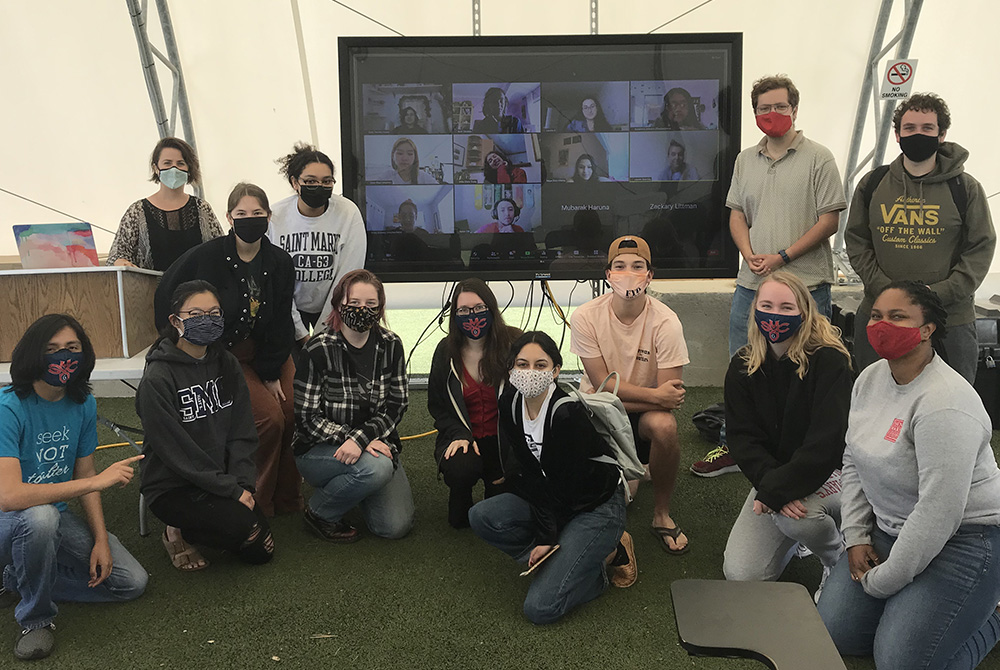
Anthropologist Anna Corwin, left rear by laptop, who has an upcoming book about Catholic sisters and aging, poses with her students at St. Mary’s College of California on the last day of their class (including online students shown on the screen). (Courtesy of Anna Corwin)
